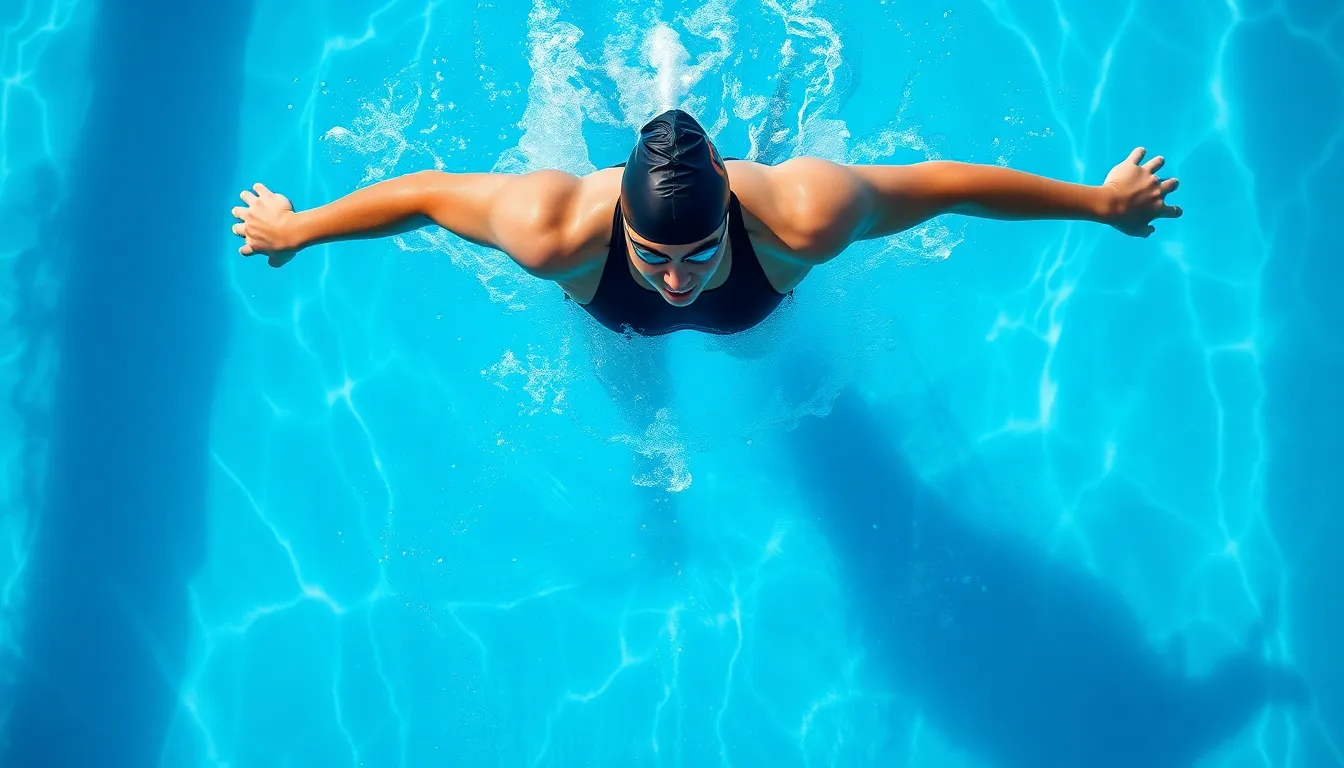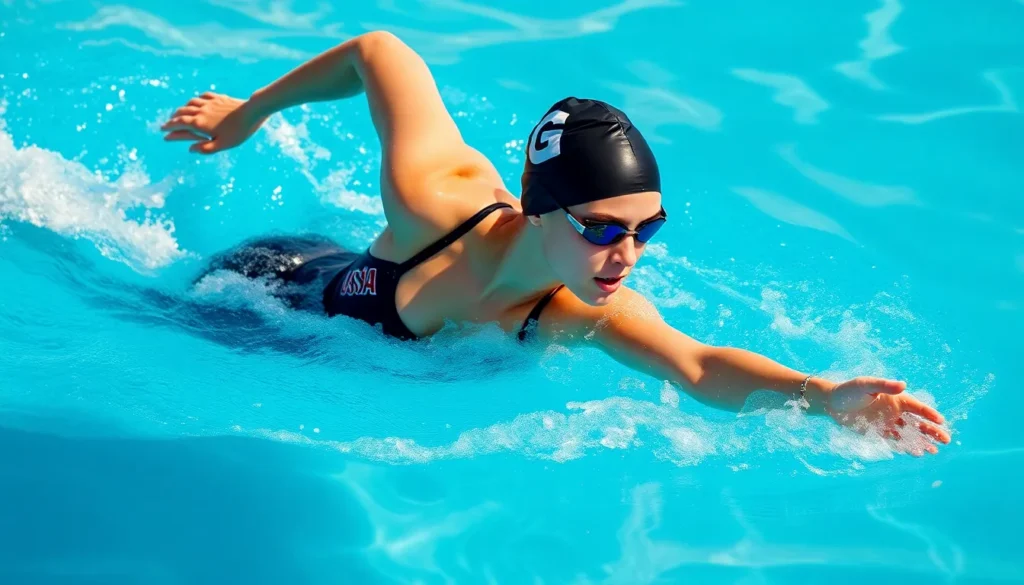Swimming a mile can seem daunting, but it’s a rewarding challenge for swimmers of all levels. Whether someone is training for a competition or simply looking to improve their fitness, understanding how long it takes to swim a mile is crucial. Factors like swimming technique, fitness level, and water conditions all play a role in determining the time it takes to complete this distance.
For many, swimming a mile can take anywhere from 30 minutes to over an hour. Beginners might find themselves on the longer end of that spectrum, while experienced swimmers often complete it much faster. This article delves into the various elements that influence mile-swimming times and offers tips to help swimmers improve their performance.
Understanding Mile Swimming
Mile swimming involves completing 1,760 yards or 1,609 meters in water. Various factors influence the time taken to swim this distance, including swimming technique, fitness level, and water conditions.
Factors Influencing Mile Swim Times
- Swimming Technique: Efficient strokes reduce energy expenditure. Techniques such as freestyle typically yield faster times compared to breaststroke or backstroke.
- Fitness Level: Enhanced cardiovascular endurance translates to faster mile times. Regular training improves stamina and speed.
- Water Conditions: Factors like temperature and current impact performance. Calm waters usually allow for quicker swims, while choppy conditions slow down progress.
Estimated Swim Times by Skill Level
The following table outlines average swim times for different skill levels:
| Skill Level | Average Time |
|---|---|
| Beginner | 30 to 60 minutes |
| Intermediate | 20 to 30 minutes |
| Advanced | 15 to 20 minutes |
| Competitive Swimmer | Approximately 15 minutes |
These times serve as benchmarks and may vary among individuals based on practice frequency and technique refinement.
Training Recommendations
- Set Goals: Establish specific time targets for progressive improvement.
- Focus on Technique: Regularly work with a coach or utilize instructional videos to fine-tune strokes.
- Increase Endurance: Implement interval training sessions to build stamina.
Monitoring these factors and implementing targeted training strategies can significantly enhance mile swim performance.
Factors Affecting Swim Time

Swim times for a mile vary based on several critical factors. Understanding how these elements influence performance can help swimmers optimize their training and results.
Skill Level
Skill level plays a significant role in swim times.
- Beginners: Swim a mile from 30 to over 60 minutes due to limited efficiency and experience.
- Intermediate Swimmers: Complete a mile in 20 to 30 minutes, showing improved technique and stamina.
- Advanced Swimmers: Achieve mile swims in 15 to 20 minutes, demonstrating mastery of skills and endurance.
- Competitive Swimmers: Typically finish in about 15 minutes, benefiting from rigorous training and experience in races.
Swim Technique
Swim technique significantly affects speed and efficiency in the water.
- Strokes: Proper stroke mechanics optimize energy expenditure and propulsion.
- Breathing: Efficient breathing patterns ensure oxygen delivery without disrupting rhythm.
- Body Position: Maintaining a streamlined body reduces drag and accelerates movement through water.
- Turns and Push-offs: Effective flip turns and strong push-offs from the wall enhance speed, especially in training.
Water Conditions
Water conditions impact swim times considerably.
- Temperature: Warmer water promotes comfort and reduces fatigue, while colder temperatures may slow swimmers down.
- Current: A strong current can aid or hinder progress, significantly altering swim times.
- Altitude: Swimming at high altitudes may present challenges due to reduced oxygen availability, affecting performance.
- Visibility: Clear water allows for better sighting, aiding navigation during longer swims.
By analyzing these factors, swimmers can better prepare for mile swims and improve their performance.
Average Times for Different Swimmers
Average swim times for a mile vary significantly among different skill levels, reflecting the swimmer’s experience and training. Below are the typical times based on proficiency.
Beginners
Beginners typically take 30 to 60 minutes to swim a mile. Their focus often lies in mastering basic techniques and building confidence in the water. Factors such as comfort level and familiarity with stroke mechanics heavily influence their swim times. As they progress, improvements in efficiency and endurance often lead to faster swim times.
Intermediate
Intermediate swimmers usually complete a mile in 20 to 30 minutes. They generally possess a solid grasp of swimming techniques and maintain a reasonable level of cardiovascular fitness. Many intermediates focus on refining their strokes and increasing their stamina through targeted training, which contributes to their improved performance over time.
Advanced Swimmers
Advanced swimmers generally finish a mile in 15 to 20 minutes. These swimmers demonstrate superior stroke efficiency, excellent breathing techniques, and strong endurance. Many advanced swimmers incorporate varied training routines, including interval training and technique drills, to further enhance speed and performance. Competitive swimmers at the elite level can complete the mile in approximately 15 minutes, showcasing the physical capabilities developed through rigorous training and experience.
Training Tips to Improve Swim Speed
Improving swim speed requires a focused approach combining endurance and technique. Implementing targeted training strategies enhances overall performance and efficiency in the water.
Endurance Training
Endurance training builds the capacity to swim longer without fatigue. Incorporate these methods for effective endurance improvement:
- Long-distance swims: Regularly swim distances greater than a mile. Gradually increase the total distance to boost stamina.
- Interval training: Alternate between high-intensity swimming and rest periods. This enhances cardiovascular fitness and helps swimmers adapt to faster paces.
- Pacing practice: Swim at a consistent pace during longer workouts. Use a stopwatch or a fitness tracker to monitor time and maintain a sustainable speed.
- Cross-training: Engage in activities like running, cycling, or strength training. These improve overall fitness and target different muscle groups, supporting swim endurance.
Technique Drills
Technique drills ensure efficiency and speed in swimming. Focus on these drills to refine stroke mechanics:
- Catch-up drill: Focus on one arm’s stroke at a time while the other remains extended. This improves arm positioning and increases stroke length.
- Fingertip drag drill: Keep fingertips dragging along the surface of the water during the recovery phase. This promotes higher elbow positioning and smoother entry.
- Breathing drills: Practice bilateral breathing or single-side breathing. This increases comfort and adaptability in various swimming conditions.
- Kicking drills: Use a kickboard to isolate leg movement. Kicking strengthens the legs and improves overall propulsion without relying solely on arm strokes.
Common Mistakes to Avoid
Avoiding common mistakes can significantly improve swim performance and experience. Some typical errors include:
- Neglecting Warm-ups: Swimmers often skip warm-ups, which can lead to muscle stiffness and reduced performance. A proper warm-up enhances flexibility and prepares the body for exertion.
- Poor Technique: Many swimmers focus solely on speed, disregarding stroke mechanics. This can result in wasted energy and slower times. Emphasizing proper stroke, breathing, and body position ensures efficiency in the water.
- Inadequate Breathing: Swimmers sometimes hold their breath instead of maintaining a steady breathing pattern. This leads to fatigue and decreased performance. Regularly practicing breathing techniques fosters a smoother rhythm during swimming.
- Ignoring Body Position: A common mistake is failing to maintain a streamlined body position. A high head or improper alignment creates drag, slowing swimmers down. Keeping the body level and streamlined reduces resistance.
- Overtraining: Swimmers may push themselves too hard without adequate rest, leading to burnout or injury. Building a balanced training schedule fosters endurance and allows for recovery.
- Inconsistent Pacing: Inconsistent pacing can disrupt swim efficiency. Swimmers should practice pacing techniques to maintain a steady speed throughout the distance.
- Disregarding Conditions: Many swimmers overlook the impact of water conditions, including temperature and current. Understanding how they affect performance helps in adjusting strategies accordingly.
- Forgetting Hydration and Nutrition: Dehydration can negatively impact performance. Swimmers should focus on proper hydration and nutrition before and after swims to maintain energy levels.
By recognizing and correcting these mistakes, swimmers can enhance their performance and effectively tackle the challenge of swimming a mile.
Swimming a mile is a significant achievement that can boost confidence and fitness. The journey to mastering this distance requires dedication and understanding of various factors that influence swim times. By focusing on technique and endurance training, swimmers can improve their performance and enjoy the process.
Avoiding common pitfalls and implementing effective strategies will lead to better results and a more enjoyable experience in the water. Embracing the challenge of swimming a mile not only enhances physical health but also fosters a sense of accomplishment. With the right approach, anyone can conquer this distance and reap the rewards of their efforts.






